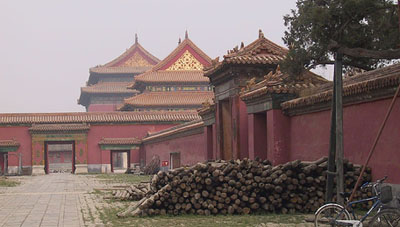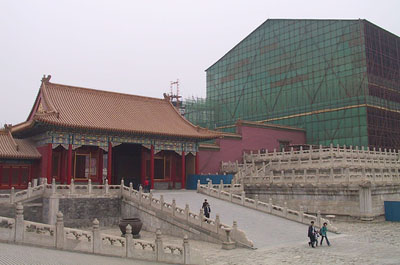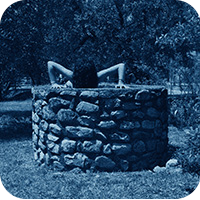Crosstown classless
“Say there, A.J., how are ya? Congrats on the World Series and all that. I was wondering, do you wear the championship right on this finger or this finger?” Whack!
Urban scar tissue
[Update: Before you send me a nastygram about being a suburban-bound latte-swilling cretin, maybe read a little more closely. I’m a huge fan of the train and urban transportation in general. Scar tissue is a metaphor, not a value judgment.]
A little over a decade ago I helped build six single-family homes in Chicago on Melrose St. just east of Lakewood Ave. We were driving posts into the dirt for a fence on an irregular diagonal property border when we hit something solid that turned out to be a railroad tie. We later learned that the screwy lot line was the result of surface train tracks that once cut through the area, the remains of which we had dug up.
I was reminded of this today by this great satellite image of the urban tissue of San Francsico reassimilating land once used by railroad tracks. Sure enough when you scale back a bit you see the same evidence of “healing” from the area around where I worked on the homes in Chicago. Roads, parking lots, buildings, row houses and, ultimately, the front door of Wrigley Field all conform to the serpentine crawl of the former track.
[Full map.]

Most interesting is that this urban scar tissue is actually part of what you might call a festering wound: a four-block portion of the line (south of this image) is still in operation serving a single customer. The path follows the route of the old Chicago & Evanston Railroad line and the functioning spur is called the Lakewood Branch. The only thing that runs on it is the Sugarland Express, a train that delivers sugar and corn syrup to the Peerless Confection Company twice weekly. Even so, the city is trying to heal over it. When the sugar train comes through residents must move their cars off portions of the tracks that serve as parking lots most of the rest of the week.
Five-year-old philosophy
My oldest one is a deep thinker. Recently as we passed some strangers on the street he asked “What happens to people when you don’t see them anymore?” He was hovering around asking whether they ceased to exist, though he never actually said so. We explained that they kept on living their own lives and that we’d probably never see them again. This saddened him a bit, though only slightly less that it puzzled him. I think he’s only just realizing that the sum of human experience is a superset of his own. Peg him for an empirical rationalist philosopher when he grows up and for god’s sake no one mention Schrödinger’s cat.
But he’s even more obsessed with names. He simply cannot understand how there can be things that do not have names. He constantly asks about how something can exist if it doesn’t have a name. I explain that there are thousands (millions?) of species of animals, mostly small critters, that we suspect exist but have not been discovered and so have not named. Not to mention undiscovered stars, comets, planets and new concepts, future fashion trends, and dance moves. This might all be prompted by the fact that we have spent the last nine months referring to his unborn sibling without precisely naming it. It would also follow from the fact that he likes to name damn near everything, even the most mundane inanimate speck. Like Adam naming stuff in Eden, the power to name is the power to make real for my boy.
Whatever it is, I think the two obsessions here are related. For my son, reality is directly experienced and labelled. If it is not directly experienced — a story, for example — or explicitly named — a baby in utero, for example — it just isn’t real.
I’ll hold off on introducing him to Second Life for now.
Chickens
I married a Southerner. Happily. This has meant many things, all positive, including an expansion of my perspective on the American experience that I’m grateful for. But it also means that my wife has a genetic predisposition to enjoying country music. True, this has mostly faded in the years since college and since we’ve moved to Chicago. But ocassionally she needs a fix and because our music is all part of one server and played through an app that sends all songs played to a server that I excerpt on this blog you’ll sometimes see my queue tainted with twang. And normally this twang comes from The Dixie Chicks.
Now, I have no specific aversion to country music. I just don’t care for it. I went to college in Nashville where I experienced a broad range of the genre, from near-folk to “new” country and everything in between. Never cared for any of it.* But whatever. The thing is, I really respect The Dixie Chicks. You might recall that they proclaimed embarrassment being from the same state as Bush a few years ago. At the time, America was preparing for war. This didn’t sit well with the bedrock mainstream radio audience of country music. Death threats were hurled, stations were boycotted, everything you’d expect from a demographic trying their best to affirm stereotypes of gun-toting, chest-beating, and a profound confusion of the difference between loving America and loving America’s leadership. The Dixie Chicks took it in stride, apologized, kept touring to sold-out crowds and that was that.
The Dixie Chicks have a new album. Country stations by and large still cave to the vocal few who find it unpatriotic to play their music. And yet, the Dixie Chicks are one of the most frequently downloaded acts on the Internet. Mainstream radio, running scared as it is from downloadable music, streaming music, and satellite radio, needs to do everything they can not to lose more listeners, but this is really quite pathetic. They are digging their own grave by not playing what people want to hear. Truth is, most people don’t really care what the Dixie Chicks or any other band stand for. They just like the music. If stations keep listening to an extreme minority they’ll end up playing only for them and fulfilling the feared outcome of not having a market that can support their ad-based model.
Not all heavy metal is about eating babies and Satan worshipping, so why should all country music be about ramming an American flag up a terrorist’s ass? Please people. The market will bear this out. If enough people are truly upset about the Dixie Chick’s stance then they will make no money, their label will drop them, and they will cease to be viable as a commercial music act. But for now, this isn’t happening. Accept it and relish the fact that most of the places that country music listeners most fear don’t embrace that kind of freedom of speech or free-market mechanism. It is as thoroughly American as a pickup truck.
[*] OK, I will admit that I do find bluegrass somewhat interesting. When I was a DJ on our college station the slot before mine was a long-running and award-winning bluegrass show. As I queued up my records and CD’s in the second studio I came to appreciate the genre in the brief slice I got over the monitors. But just you try to make a smooth segue from banjo to Front 242. Not possible.
Names and bein’ a kid
With thanks to Baby Roadies for the idea, here are the 10 worst names for our soon-to-arrive child based on Chicago streets:
- Wacker Tolva
- Hubbard Tolva
- Elston Tolva
- Irving Park Tolva
- Lawrence Tolva
- Damen Tolva
- 31st Street Tolva
- Randolph Tolva
- Fairbanks Tolva
- Sangamon Tolva
And the 10 best:
- Superior Tolva
- Sedgewick Tolva
- Ogden Tolva
- Locust Tolva
- Balbo Tolva
- Racine Tolva
- Archer Tolva
- Bryn Mawr Tolva
- Grand Tolva
- Weed Tolva
And with thanks to Solider Ant here are 10 things that “make me feel like a bright-eyed little kid again”:
- Dunkin’ Donuts vanilla long johns
- Organizing space-theme LEGO minifigs into battalions
- Playing organ notes with the foot pedals
- The Superfriends
- Cassette tape dubbing
- Playing short-ball “tennis” on the driveway
- Choose Your Own Adventure
- The Magikist Lips
- Raiders of the Lost Ark
- Playing with my own kids
Culinary turntablism
Does anyone remember the scene in The Golden Child — maybe I should first ask, does anyone remember the movie The Golden Child? From 1986, with Eddie Murphy? Not one of his best. There’s this scene where he enters a Nepalese temple and encounters a ceremonial pillar that rotates around its vertical axis. Not knowing what to do, he scrubs it like a turntable DJ, making a scratching noise. Laughter ensues.

I think of that scene when I eat out in China because of the mechanism known as the zhuan pan at the center of the table. Known in the west as a lazy susan, this rotating platter is a fixture at traditional tables in China. It is both an efficient delivery mechanism and a wonderful social lubricant. Everything is communal and by definition participatory as the platter rotates forth and back. You just reach in with your chopsticks as a dish you like comes by. If you can get beyond the sanitary issues of this particular disease vector it becomes clear that the zhuan pan is a marvelous thing.
There’s something musical about the whole process. The zhuan pan is a DJ turntable set up.

Consider it this way. The dishes are notes/chords/samples — discrete musical units of some kind. They appear at a point in time on the platter and rotate more or less consistently until they are removed or moved (more on this in a moment). So you have discrete units repeating in time from the perspective of a fixed point which in this case is me, the eater, but metaphorically is the armature of the phonograph. Units are added in time, layered in so to speak, and repeat at the same interval. Dishes leave the table periodically — their particular musical loops end. But the dishes return, smaller this time (the waitstaff transfers uneaten portions to smaller plates to make more room on the table) and they are placed closer in to the center of the rotating platter, allowing people easier access to the newer, fuller dishes at the periphery. In other words, the loops return in a changed state and with new, quicker intervals (rotating more quickly since their radial distances are now shorter). The zhuan pan rotates backwards too, but only quickly, a “scrub” if you will, to let someone grab a morsel that made its way by too quickly. The overall motion is forward.
Data visualization geek that I am I started considering the possibilities — which of course weren’t visual at all but more like data sonification (a field to be sure but not one much popularized). What would this meal sound like if the zhuan pan were a recording?

So I recorded each dish as a separate track in GarageBand. Each measure corresponded to one minute of the meal starting with the arrival of tea, which is the downbeat bass drum that remains constant throughout, the engine of the entire affair. Each new dish comes in more or less as I recorded it on a timeline in my notebook during the meal. (My hosts graciously obliged my notetaking as the curiosity of a unaccustomed Westerner.) Some dishes are single notes, some are short phrases, and at least one, the fish “flower,” is a constant note modulating in time with the rotation of the table. Each unit repeats with a period of five minutes. This is an average based on the number of revolutions of the table, but it is almost exact for at least the first two rotations of the 50 minute-long meal. With the exception of the tea-beat, volumes fade out for each track based on the consumption of the dishes. As noted above, the period of at least one dish, West Lake soup (represented by the piano), speeds up midway through the meal as it was transferred to a smaller plate and move closer to the center of the table, rotating faster. The two vinyl scratches correspond to an extended counter-rotation of the table. At 60 BPM one second correponds to roughly one minute of elapsed meal time. I think the time signature is 5/4, but I’m rusty on my Brubeck so who knows.
It is not what I’d call a chart-topper, but it isn’t cacophonous, though at quicker BPM’s it does get a bit muddy. I clearly could have done more. Instrumentation could be made to correspond more closely to the food type. (But what does “silver agaric” sound like?) Discord could be used to suggest tastes I did not care for. But the general idea is clear. Maybe on the next trip I can videotape the whole thing for the time-lapse music video this cries out to be.

In China you often encounter a circular jade plate known as a bi. It is ancient in origin and its purpose is not completely understood. The bi is flat and usually has a circular hole at the center. Movable type, gunpowder, paper. The recordable disc?
Invaders of Basilicata
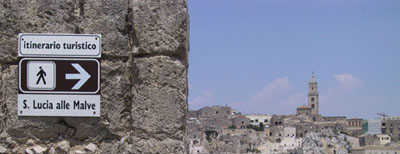
You kinda knew this was coming. Tourists are finally discovering Basilicata, the last untrammelled region of Italy. I’ve written a few times about why I think this part of Italy is so wonderful and it is true that a part of what makes it wonderful is that you just don’t encounter many tourists. Yet, the world needs to discover Basilicata and, apparently, it is.
A few signs that Basilicata is breaking out:
The May 2006 “Europe” issue of Travel and Leisure Magazine has a long piece on “Italy’s Secret City,” Matera, one of the provincial centers of gravity of Basilicata and one of the oldest continuously-inhabited cities in Europe. The online version of Travel and Leisure proclaims it more bluntly: Italy’s last, secret corner: Basilicata.
The April 2006 edition of Gourmet Magazine asks on the cover “Have You Been To Basilicata?” and delivers a full food-centric tour of the region. (The article is not online, but two of its recipes are.)
In the last few years at least two book-length travelogues have been written about Italy’s instep: Seasons in Basilicata and Under the Southern Sun.
My posts on Basilicata seem to have caught the attention of at least one of the members of Basilicata’s regional government. Recently he sent me a boxload of material relating to external promotion. Guides to wines and olive oils of the region, a CD of music to eat by (not kidding) by a classical composer from Basilicata, multimedia, maps, storybooks, cookbooks, catalogues of arts and crafts. These materials are all new. The regional government seems to be making a big tourism push. They have an advantage too in that a large percentage of foreigners with Italian heritage had ancestors from Basilicata. (The story of why — the destitution of the area in the 19th and 20th centuries — is a subject for another post.) Called the Lucani nel mondo, or Basilicatans of the world, these “expatriates” are a prime target for the new tourist marketing.
So, Basilicata is starting to shake the stereotype of bumpkin backwardness and desolation. This may mean that it will no longer serve as the backdrop of choice for religious moviemakers, but such is life. Basilicata and the south of Italy have for centuries been the Mediterranean waystation for marauding hordes and conquerors (a fact which gives it a greater diversity of cultural influences that regions to the north), so it is only fitting that they are now welcoming a different set of hordes — this time on their own terms.
8 days (crammed into less than) a week
That’s pretty much how I feel as I recuperate from an exhausting four days in Beijing.
This was the first trip to China where I truly experienced Wikipedia withdrawal. You really don’t know what you’ve got until it is blacklisted by a state government. I worry about the larger implications of this.
I always chuckle at the Chinese entry document when you are asked to check the box corresponding to your intention: Business, Conference, Official, Other (huh?), etc. There’s a box that says Settle Down. I’m tempted to check it. What does that mean? Give me your poor, your tired, your crazed Westerners looking to just settle down? I imagine the schoolmarm at passport control looking at me stoically and saying “You just need to relax, hmmm?”
I’ve realized now, after my seventh trip to the Far East, that the timeshift is truly diabolical. I suppose it is my own fault. When working in Europe and the Middle East you basically have an elongated work day. Do your thing there, return to the hotel, log on, work with your colleagues back home for a few hours at the start of their work day. In China, it is like this but with about a five hour gap between the end of the Chinese work day and waking Americans. After a few days of this the only reasonable thing to do is sleep during this period. Which completely destroys any hope of a sustainable schedule. The day becomes split: awake 6am-6pm, sleep 6pm-10pm, awake 10pm – 2am, sleep, etc. Awful. Maybe I should just treat it like a vacation from work back home.
That said, I can’t complain. Working at the Forbidden City is a special treat. IT geeks are almost always housed in basements, dungeons, or worse — and when I work there I am in a temporary trailer — but how bad can it be when you step out to this?
The Forbidden City is surrounded by a wide moat on all four sides. It is stagnant and forboding, as a defensive moat should be, I suppose. Yet, there are always a few dozen people fishing in it. I’ve never seen anyone pull anything living out of it, but from the size of the poles they use (without reels) I am pretty sure they are angling for some sort of slithering leviathan the size of a bus.
Our colleagues at the Forbidden City again hosted a ping pong tournament. I should have learned from the first drubbing last year. I think I lost 11-7, 11-8 which sounds way closer than it was. Yes, my opponent held his paddle upside-down, yes he stood way the hell back and played many of my shots after the ball had dropped below the plane of the table on his side, but what really threw me off was his serving ritual. He’d pet the table up by the net, move back, bounce the ball slowly on his paddle held parallel to the table, tuck it all back in close to his body (so I could not see it clearly), then whip out a serve that never went where I thought it would. If I managed to return it the shot was so lame that I was shortly searching for the ball ricocheting between server cabinets way behind me. Still, it was good fun and I really love that Chinese television always has professional ping pong coverage on. Taunting, yelling, sweating, injuries — the way ping pong should be.
Regeneration
In The Future of the Past, Alexander Stille expands on a comment by Italian conservator Michele Cordaro:
“The Chinese, like the Japanese and some other Asian nations, have a tradition of conserving by copying, or rebuilding.”
Conserving by rebuilding made considerable sense in China, where, until recently, virtually everything — palaces, temples, and houses — was built of wood. Paradoxically, in architecture, working in perishable materals could potentially offer a superior conversation strategy: rotting wooden parts could simply be replaced as needed so that, just as our bodies replace their old cells with new ones while we remain “ourselves,” the buildings would be constantly regenerated, remaining forever new and forever ancient.
Seems logical, but in practice Western conservation is based on a philosophy of repair rather than replacement. This stems from the West’s long privileging of permanence and originality in art (even when what we praise isn’t in fact permanent or exceptionally original). Copies are considered at best qualitatively lesser; at worst, acts of piracy.
These conflicting attitudes toward monuments are related to profound cultural differences. China and Japan have traditionally had a cyclical view of time. Dynasties would rise and fall, be replaced by new ones, but, like the Forbidden City, reemerging from its latest fire, remain fundamentally the same: each ruling group held the “mandate of heaven” …. In a world that was both eternal and ever-changing, rebuilding monuments made perfect sense.
This past week I had the good fortune to be invited on a tour of the renovation of the roof of the Hall of Supreme Harmony at the Forbidden City in Beijing. This is the most important of the hundreds of buildings at the Forbidden City, now known also as the Palace Museum. The whole museum is being upgraded (as is all of Beijing, for that matter), but the work is most intense at the Hall of Supreme Harmony where a giant scaffolding and tent covers the swarm of workers who are in the process of removing the thousands of decaying terracotta tiles to get at the wooden infrastructure of the roof. The tiles are being meticulously removed and remade. The roof itself is imperceptibly sagging and this will be repaired too. The intricately painted outer beams will be repainted, resulting in stunning before and after comparisons. (Full photoset tour at Flickr.)
This is a less extreme version of wholesale rebuilding of cultural sites that Stille details in his study of Chinese conservation, but it is an example nonetheless. Only a specialist could point to what is original to the hall’s 1406 construction and what parts are copies installed since. This happens in the West too, of course, but the difference as I’ve experienced it in China is that it doesn’t matter. The originality of the building is the idea of it, what it represents.
The Palace Museum has a partnership with the Japanese printing company Toppan to create a detailed, high-resolution virtual replica of the Forbidden City. Right now only three of the main halls, including Supreme Harmony, are complete. The effect of moving about the virtual grounds in the wrapround-style theater is powerful, though in the people-free virtual model the awe created by the buildings’ scale is missing. There’s little aura to the simulacrum. The model will improve, of course, as the technologies of virtuality improve.
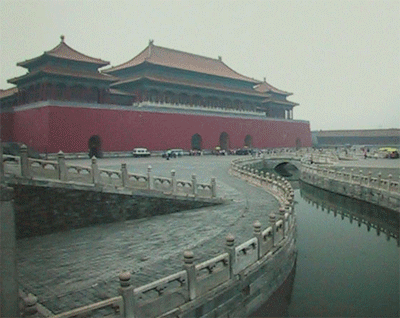
Comparison of a photograph and a still from the virtual model
No one claims that the model is the Forbidden City, but then you don’t get the usual quasi-apologies about its not being the “real” thing either. Most 3D modelling in cultural heritage is done for a specific purpose — reconstruction of what has been lost, for instance — and is treated as a teaching tool or a research resource. Not so at the Palace Museum. It will be interesting to see how this copy evolves.
What a smile ’round my face
Yikes, it has been a silent week ’round these parts. My travels in China have been crushing: a full work day on Beijing time plus 75% of a work day on US time. While this makes for a lot of time in front of the computer it does not produce much of a clear head for blogging. And this is why I am writing now from my flight 35,000 feet above the Pacific. This is my first flight with WiFi broadband and I just need to geek out a bit and say this changes everything. Time was, international flights were like day-long technology isolation chambers, but now that I have a connection (and a pretty fast one at that — 802.11g) it gets all screwy. I’m adapting my already nutty sleep schedule to Chicago time so that I can Skype with my wife. And the beauty of that, of course, is that we just leave it on the entire flight. She hears me; I hear all the goings-on at home. — for 10 hours. Just like ignoring each other at our own computers when we are under the same roof. Seriously though. This changes so much. I’ve watched streaming video, listened to iTunes radio, videoconferenced with a pal, Skyped my wife, and obviously e-mailed and surfed. Am I overdoing it this time? Absolutely. Will this go down as the best thing to happen to me before my baby arrives in a few weeks. Absolutely.
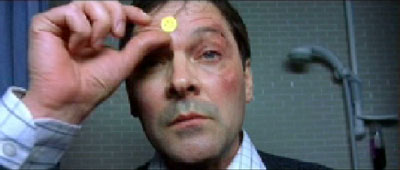
International travel alone is rough, but for some reason Four Tet’s “Smile Round the Face” cheers me up every time I watch it. It took me a few viewings to realize what seems so obvious: being a daddy is it’s own reward. Thanks, Kieran, for the cheer.
More China double happiness soon …


